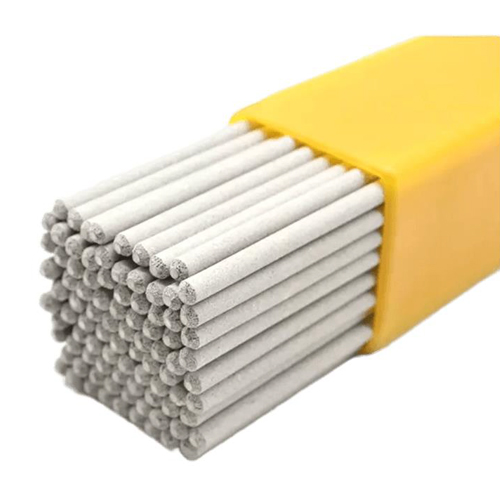

íshín-240S has nominal composition (wt. %) of weld metal 18 Cr, 5 Ni, 12 Mn, and 0.20 N. These electrodes are most often used to weld AISI Type 240 and 241 base metals. These alloys are nitrogen-strengthened austenitic stainless steels exhibiting high strength with good toughness over a wide range of temperatures. Significant improvement in resistance to wear in particle-to- metal and metal-to-metal (galling) applications is a desirable characteristic when compared to the more conventional austenitic stainless steels like Type 304. Nitrogen alloying reduces the tendency for intergranular carbide precipitation in the weld area by inhibiting carbon diffusion and thereby increasing resistance to intergranular corrosion. Nitrogen alloying also improves resistance to pitting and crevice corrosion in aqueous chloride-containing media. In addition, weldment in Alloys AISI 240 and AISI 241 when compared to Type 304, exhibit improved resistance to trans granular stress corrosion cracking in hot aqueous chloride containing media. These electrodes have sufficient total alloy content for use in joining dissimilar alloys like mild steel and the stainless steels, and for direct overlay on mild steel for corrosion and wear applications.
These electrodes are designed for flat and horizontal fillet welding. In practice, most of these electrodes give higher deposition rates than their all-positional counterparts owing to their thicker coatings that contain higher levels of metal powders. The thicker coating gives larger fillet welds that are typically flat to concave. It also reduces the effects of core wire overheating, making 450 mm long electrodes possible for the larger electrodes, even with stainless steel core wire. Higher currents are usually required to achieve the necessary penetration compared to the all-positional types. The slag system of these electrodes is like those of the - 16 and -17 designations. The resulting slag may be more fluid and even slower freezing than that from -17 electrodes. The -26 electrodes are recommended for welding only in flat and horizontal fillet positions. Out of position welding may be possible with electrode sizes up to 3.2 mm diameter.
Storage and Drying Conditions: Hydrogen can have adverse effects on welds in some steels under certain conditions. One source of this hydrogen is moisture in the electrode coverings. For this reason, the proper storage, treatment, and handling of electrodes are necessary.
Holding Ovens: 125°C–150°C.
Drying Conditions: 250°C–425°C for 1 hour prior to use.
CHEMICAL COMPOSITION OF UNDILUTED WELD
|
C |
Cr |
Ni |
Mo |
Nb+Ta |
Mn |
Si |
P |
S |
N |
Cu |
Others |
|
0.06 |
17.0-19.0 |
4.0-6.0 |
0.75 |
NS |
10.5-13.5 |
1.00 |
0.04 |
0.03 |
0.10-0.30 |
0.75 |
NS |
Single values are maxima, except where specified otherwise.
ALL-WELD-METAL MECHANICAL PROPERTIES
|
Tensile Strength, MPa |
Yield Strength, At 0.2% Offset, MPa |
Elongation % |
Lateral Expansion, mm |
Charpy V-Notch Impact at NS°C, Joules |
|
690 |
NS |
15 |
NS |
NS |
Single values are minimal.
ELECTRODE SIZE & WELDING CURRENT (AC and DCEP)
|
DIAMETER, mm |
LENGTH, mm |
Amperes |
|
2.50 |
350 |
65-90 |
|
3.15, 3.20 |
350 |
90-120 |
|
4.00 |
350 |
120-150 |
|
5.00 |
350 |
160-200 |
WARNING: Safety and health information is available from many sources, including, but not limited to Safety and Health Fact Sheets listed in A11.3, ANSI Z49.1 Safety in Welding, Cutting, and Allied Processes published by the American Welding Society, 8669 Doral Blvd., Suite 130, Doral, FL 33166., and applicable federal and state regulations. The Safety and Health Fact Sheets are revised, and additional sheets added periodically.
